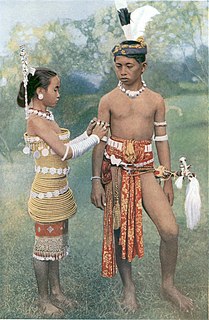
The Dayak or Dyak or Dayuh are one of the native groups of Borneo. It is a loose term for over 200 riverine and hill-dwelling ethnic subgroups, located principally in the central and southern interior of Borneo, each with its own dialect, customs, laws, territory, and culture, although common distinguishing traits are readily identifiable. Dayak languages are categorised as part of the Austronesian languages. The Dayak were animist in belief; however, since the 19th century there has been mass conversion to Islam as well as Christianity due to the spreading of foreign religions.

Babywearing is the practice of wearing or carrying a baby in a sling or in another form of carrier. Babywearing has been practiced for centuries around the world. In the industrialized world, babywearing has gained popularity in recent decades. Part of the reason for this shift is due to the influence of advocates of attachment parenting. Babywearing is a form of baby transport which can be enjoyed for as long as mutually desired, often until toddlerhood and beyond.

Kaharingan is an animistic folk religion professed by many Dayaks in Kalimantan, Indonesia; particularly Central Kalimantan, although many have converted to Christianity or Islam or follow a syncretic religion. It is estimated that most Dayaks follow their ancient animistic religious traditions (Kaharingan), but often claim to belong to one of the recognized religions in Indonesia to prevent discrimination.

Being an indigenous tribe in Borneo, the Kayan people are similar to their neighbours, the Kenyah tribe, with which they are grouped together with the Bahau people under the Apo Kayan people group. The Kayan people are categorised as a part of the Dayak people. They are distinct from, and not to be confused with, the Kayan people of Myanmar.

Banjarmasin is a city and capital of South Kalimantan, Indonesia. It is located on a delta island near the junction of the Barito and Martapura rivers. Historically the center of Banjarese culture and capital of Sultanate of Banjar, it is the biggest city in South Kalimantan and one of main cities in the entire Kalimantan. The city covers an area of 98.46 square kilometers with an estimated population of 657,663 in 2020. Greater Banjarmasin, also known as Banjarbakula, is an urban agglomeration of around 2 million people covering an area of 8,136 square kilometers which also includes Banjarbaru, parts of Banjar Regency, Barito Kuala Regency, and Tanah Laut Regency and accounts almost half of the province's population. It is the third most populous city in the entire Borneo island after Samarinda and Balikpapan, and the most populous officialy-recognized metropolitan area in the entire island, more than three times the population of Kuching metropolitan area, the second largest officially-recognized metropolitan area in the island.

The Murut are an indigenous ethnic group, comprising 29 sub-ethnic groups inhabiting the northern inland regions of Borneo. The Murutic languages are a family of half a dozen closely related Austronesian languages. The Murut can be found mainly in Sabah, Malaysia including in Sarawak, Malaysia, Brunei, and Kalimantan, Indonesia.

Palangka Raya is the capital and largest city of the Indonesian province of Central Kalimantan. The city is situated between the Kahayan and the Sabangau rivers on the island of Borneo. The city has a population of 291,667. Palangka Raya is the largest city by land area in Indonesia. Most of the area is forested. It is city with the largest area in Indonesia, approximately four times the size of Jakarta. It is also the most developed city in the entire Kalimantan in terms of Human Development Index.

Mandau is the traditional weapon of the Dayak people of Borneo. It is also known as Parang Ilang among the Bidayuh, Iban and Penan people, Malat by the Kayan people or Baieng by the Kenyah people or Bandau by Lun Bawang or Pelepet/Felepet by Lundayeh. Mandau is mostly ceremonial. However, a less elaborate version called Ambang is used as an everyday practical tool.

Lemang is a Minang traditional food made from glutinous rice, coconut milk and salt, it is cooked in a hollowed bamboo tube coated with banana leaves in order to prevent the rice from sticking to the bamboo. It is found in Maritime Southeast Asian countries, especially in Indonesia, Malaysia, Brunei, and Singapore, as similar dishes made from sticky rice in bamboo are common throughout Mainland Southeast Asia.
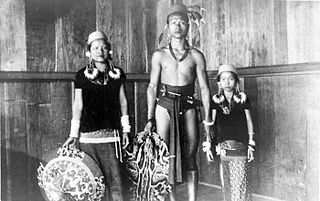
The Kenyah people are an indigenous, Austronesian-speaking people of Borneo, living in the remote Baram, Data Kakus, Data Surau, Senap River, Long Dungan, Long Busang, Long Beyak, Bintulu, Miri, Asap River resettlement for Bakun Dam, Long Bulan, Long Jawe and Belaga regions in Sarawak, Malaysia and the remote Apau Kayan, Bahau (Bau), Benua Lama, Benua Baru and Mahakam regions in East Kalimantan, Indonesia.
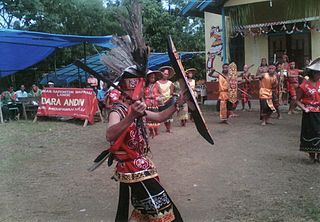
The Kendayan are an Indonesian ethnic group native to Kalimantan, Indonesia in Borneo. The population of the group is around 366,000.
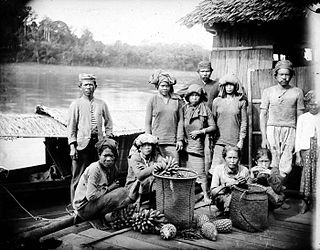
Bakumpai or Baraki are indigenous people of Borneo and are considered as a sub-ethnic group of the Dayak Ngaju people group with Islamic background. The Bakumpai people first occupy along the Barito riverbanks in South Kalimantan and Central Kalimantan, from Marabahan to Puruk Cahu, Murung Raya Regency. The Bakumpai people first appeared as a newly recognized people group in census 2000 and were made up of 7.51% of Central Kalimantan population, which before this the Bakumpai people were considered as part of the Dayak people in a 1930 census.

The Tidung, Tidong are a native group originating from northeastern part of Borneo and surrounding small islands. They live on both sides of the border of Malaysia and Indonesia.
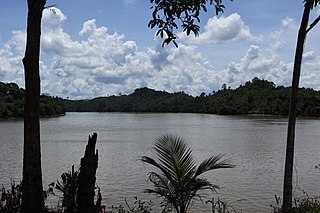
Kayan River is a river of Borneo island, flowing in the North Kalimantan province of Indonesia, about 1600 km northeast of the capital Jakarta. Tributaries include the Bahau River.

Daun ubi tumbuk is a vegetable dish commonly found in Indonesia, made from pounded cassava leaves. In Indonesian, daun means leaf, ubi refers to cassava, and tumbuk means pounded. The cassava leaves are traditionally pounded with a wooden mortar and pestle, although finely chopping or puréeing them using a blender or food processor is an alternative.

North Kalimantan is a province of Indonesia. It is located on the northernmost of Kalimantan, the Indonesian part of the island of Borneo. North Kalimantan borders the Malaysian states of Sabah to the north and Sarawak to the west, and by the Indonesian province of East Kalimantan to the south. Tanjung Selor serves as the capital of the province, while Tarakan is the largest city and the financial centre.
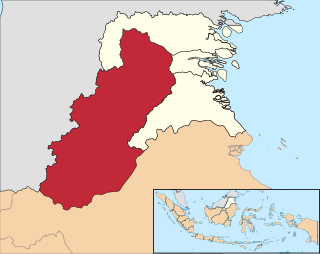
Malinau Regency is a regency of North Kalimantan Province in Indonesia. The administrative centre is the town of Malinau. Malinau is also often called Earth Intimung. The district is home to the Kayan Mentarang National Park. It covers an area of 40,088.41 km2, and had a population of 62,423 at the 2010 Census; the latest official estimate is 90,382. In terms of demographics and religion, Malinau is the only regency in North Kalimantan that is predominantly Protestant.
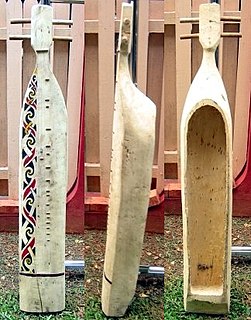
The sape' is a traditional lute of the Kenyah and Kayan community who live in the longhouses that line the rivers of East Kalimantan, Indonesia. Sapes are carved from a single bole of wood, with many modern instruments reaching over a metre in length.
Kancet Papatai is a traditional Indonesian war dance about a war hero and his struggle against the enemy. The dance also describes his courage and the ceremony awarding him the title Ajai, for his victory.

The Apo Kayan people are one of the Dayak people groups that are spread throughout Sarawak of Malaysia, East Kalimantan and North Kalimantan of Indonesia. The earliest Apo Kayan people are from the riverside of the Kayan River, Bulungan Regency, East Kalimantan, Indonesia. According to the Apo Kayan Dayak legend, the Kayan people are the forefathers of which all smaller sub-ethnic Dayak people that are found along the Kayan River came from. Today, the population of the Apo Kayan people are estimated about 64,900.



















